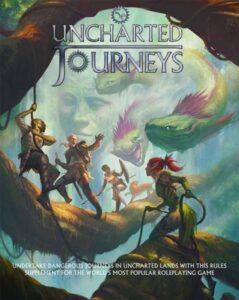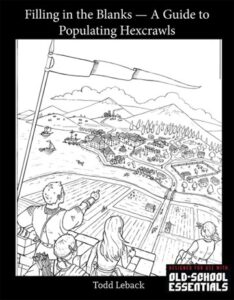I’m midway through reading a bunch of different RPG products at the moment, none of which I’ve really dived into enough to feel confident about writing a full review, but I thought I’d give you a few thoughts on a couple of products relating to wilderness play.
Uncharted Journeys (Cubicle 7)
I’ve written quite a bit about this already as I’ve been using it in my games. I’m very split on this product. I think the concept of it is awesome, and I absolutely recommend it as a source of great wilderness encounters, including a lot of things you won’t see in regular D&D play.
A lot of wilderness encounters out there boil down to an entry that is “2d6 orcs”. This isn’t how Uncharted Journeys handles it. Instead, it handles monuments, monsters in unusual situations, hazardous terrain – and all in a way that is evocative but also is resolved easily. Characters take responsibilities (roles) at the beginning of each journey, and those roles have real impacts on the encounters that occur. If the Outrider (scout) rolls well in one encounter, everyone else gets advantage to overcome its perils. An encounter with refugees is made easier if the Quartermaster can find supplies to aid them.
Part of the core conceit is that the journey is a dangerous affair: you don’t get to rest unless you come to a place that allows it. So, instead of the problem of one encounter per day which you have full resources for (and you’ll get them all back for the next encounter), instead you need to manage your resources carefully because you are expending them in travel.
This is great. However, it then fatally lowballs the number of encounters in a trip. A medium journey (up to 300 miles) gets TWO encounters, and if the players roll well when setting out, that gets reduced to one. The entire balance of the system only really works when you have four encounters on a journey, and yet this only happens on the longest journeys.
I also find that the random encounters often give too many encounters of low impact. Having “A Place to Rest” be one of two encounters on the journey – and it the first one? – isn’t great. The way you set the DCs for the travel, which is based on terrain type and weather – doesn’t work well. If the weather is tolerable and you’re travelling across a steppe, high-level characters will make every check with ease… despite the steppe being chock-full of dangerous monsters. I advise throwing out the suggested DC and setting one based on the capabilities of your party.
Lots of great things about this product, but it needed more time in development – and the assumptions it makes about encounter variety may not be the ones you make for your campaign.
Filling in the Blanks (Third Kingdom Games)
This is a supplement for OSE (a retroclone of B/X D&D), but applicable to other D&D-style games. It presents a method of generating the contents of a wilderness map so that players can always find interesting things in a hexcrawl.
What’s a hexcrawl? Well, it’s the opposite type of journey than that of Uncharted Journeys. UJ works best when you know your destination and you want to represent what obstacles and challenges you face on the journey. In a hexcrawl, you’re doing pure exploration – going onto a blank map and wandering around the terrain looking for interesting things. It’s often paired with territory acquisition and rulership.
It’s very easy for the DM to end up with a mostly blank map with only a few areas of interest and relying on random encounters. The old adventure Isle of Dread was this way, and one reason it often felt flat in play, despite having evocative areas. With Filling in the Blanks, the map ends up chock-full of areas of interest. The main scale it addresses is six-mile hexes, but it then subdivides those into 1.1 hexes, so that you can have multiple areas of interest in a six-mile hex. Although it does recognise that perhaps the GM only wants one area of interest per six-mile hex and has a separate table for that.
With 100 pages of content and chapters covering such topics as Geologic Features, Structures, Resources, Hazards, and Dungeons, there’s a LOT of detail here.
And probably too much for many campaigns. I am not disappointed. I probably will never use the full system, but setting up a hexcrawl for a future campaign sounds fun, and I like having resources like this. I’m going back to my Monday Greyhawk campaign for a short time soon (after we finish The Shattered Obelisk and before we play Vecna: Eve of Ruin), so that’s most likely where I’ll use it first.
I have it in a the “Into the Wild” omnibus edition with rules on running hexcrawls and running a thieves’ guild as well, but for the 5E player, it’s this section that is most interesting.



I’ve also been using Unchartered Journeys in my new campaign, and have kept it simple as we get used to the system, so it’s been fairly ease into. I’m about to increase the encounters though for the same reason you mentioned, and will probably set the default starting encounter at something higher instead of 10 to maybe even 15 — 6 players means lots of people to help lower the DCs back. I like the ideas in it a lot, though, and look forward to seeing it in play longterm.
Yeah. For my level 10 party, they typically reduce the DC by 4, so I’m thinking a DC 18-20 base is needed and might go higher!
I’m hoping that continued play will allow me to determine a consistent system of adjustments!
Very interested to read your thoughts on Uncharted Journeys. I got it for Christmas and haven’t got to it yet.
How does Uncharted Journeys compare to the journey rules from Adventure in Middle Earth? I think the UJ flexare based on the AiME ones.
I’ll try and give a comparison in a new post this week.
Thanks for the Uncharted Journeys review! I’d been interested in it but, from your comments, it doesn’t sound like the product for me.